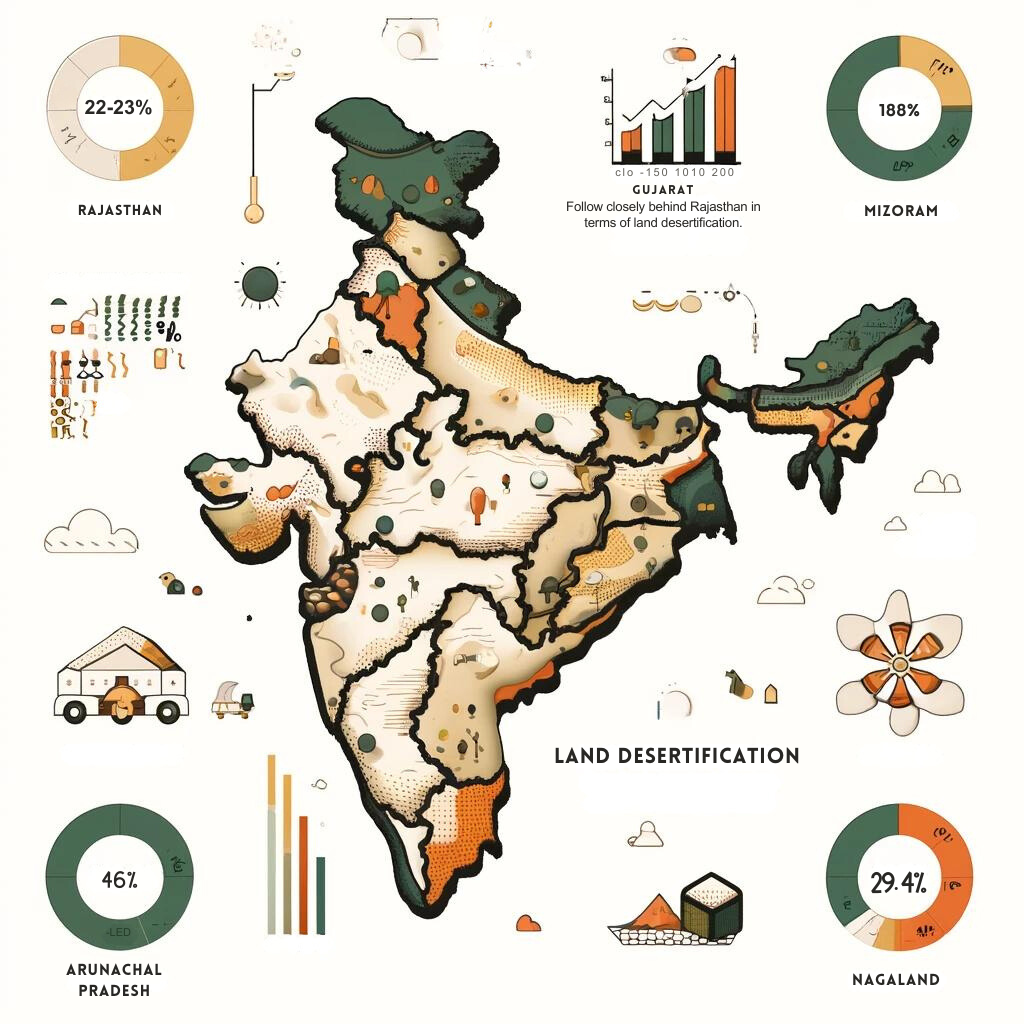Desertification is a silent crisis gripping India, with a staggering 25% of its landmass undergoing this process. While scorching summer temperatures and record highs grab headlines, the underlying issue—unchecked desertification—demands immediate attention because this insidious process silently transforms fertile lands into arid wastelands. Desertification is not merely an environmental concern, it poses a significant threat to India’s food security, economic stability, and the very foundation of its agricultural prowess. More than half of the degraded land in the country is either rainfed farmland, responsible for the food security of the country, or forest land, which offers the best defense against climate change. Therefore, effectively addressing desertification is crucial for ensuring the long-term sustainability of India’s land resources and the well-being of its population.
Origin of the Article
This editorial is based on “A quarter of India’s land is undergoing desertification. Stop this. Trees defend against soaring heat,” which was published in Times on India on 31/05/2024. The article brings into the picture the looming threat of desertification in India and the need to reverse this menace.
Relevancy for UPSC Students
Understanding desertification is crucial for UPSC aspirants as it is related to multiple aspects of the UPSC syllabus, including geography, environment, and biodiversity. It also helps in comprehending the broader implications of food security, economic stability, and climate change, which are vital for the Mains examination. Knowledge on this topic can also aid in answering environment-related questions in the Prelims.

Why in News
The issue of desertification is crucial for UPSC aspirants due to its multifaceted impact on India’s environment, food security, and economic stability. The topic has been prominently featured in past UPSC exams, such as the 2020 Mains question on desertification transcending climate boundaries. Understanding this topic helps aspirants grasp the interconnectedness of environmental degradation, policy measures, and socio-economic consequences, which are vital for both Prelims and Mains preparation.
Status of Desertification in India
Desertification is a significant environmental concern in India, with nearly a quarter of the country’s landmass affected. Over the last 15 years, almost all states have seen an increase in degraded land. This alarming trend calls for immediate attention and concerted efforts to halt and reverse the damage. Effective management of land resources is crucial for ensuring long-term sustainability and food security.

State-wise Data
Rajasthan leads with 22-23% of its land undergoing desertification, followed by Maharashtra and Gujarat. Mizoram, with a staggering 188% increase in degraded land between 2003–05 and 2018–19, highlights the urgency of the situation. Arunachal Pradesh saw a 46% increase, and Nagaland experienced a 29.4% rise. Such data underscore the widespread and escalating nature of desertification across India.
Affected Land Types
Rainfed farmlands, covering 37 million hectares, are severely impacted, with water erosion accounting for 80% and wind erosion for 17%. Forest lands, approximately 21 million hectares, also suffer, primarily due to vegetation degradation (96%). These figures reveal that both agricultural and forested areas are significantly compromised, threatening the country’s ecological balance and agricultural productivity.
Factors Leading to Desertification in India
The primary drivers of desertification in India include both human activities and natural processes. Deforestation, overexploitation of groundwater, salinity ingress in coastal areas, unregulated mining, inadequate policy implementation, rapid urbanization, and the invasion of alien plant species are critical factors. These elements collectively accelerate land degradation, necessitating comprehensive strategies for mitigation.
Deforestation and Forest Degradation
India’s demand for timber, agricultural land, and settlements leads to rampant deforestation. The Western Ghats, for instance, have lost 5% of their evergreen forest cover. Such loss of vegetation exacerbates soil erosion and reduces the land’s capacity to support agriculture, furthering the desertification process.
Overexploitation of Groundwater
Excessive groundwater extraction for irrigation and industrial use depletes water tables, causing land subsidence and reduced soil moisture. Punjab and Haryana are prime examples, where over-extraction has led to significant declines in groundwater levels, contributing to desertification concerns in these regions.
Salinity Ingress in Coastal Areas
In coastal regions like Gujarat and Tamil Nadu, seawater intrusion into groundwater aquifers causes soil salinization, reducing agricultural productivity. An estimated 627 villages in Saurashtra and Kutch are severely affected by salinity ingress, highlighting the need for effective management of coastal resources.
Mining and Industrial Activities
Unregulated mining and industrial operations contribute to soil contamination, air pollution, and land degradation. The Jharia coalfields in Jharkhand are a notable example where mining activities have led to significant land subsidence and desertification, adversely impacting the surrounding areas.
Inadequate Implementation of Land Degradation Neutrality
Despite India’s commitment to the UNCCD and the goal of achieving land degradation neutrality, the implementation of related programs remains inadequate. This inadequacy results in regional disparities and hampers efforts to combat desertification effectively.
Urbanization and Infrastructure Development
Rapid urbanization and large-scale infrastructure projects, such as the Delhi-Mumbai Industrial Corridor, lead to the loss of productive agricultural lands and disruption of natural ecosystems. Such developments exacerbate desertification by removing vegetation and altering land use patterns.
Invasion of Alien Plant Species
The spread of invasive alien plant species, like Prosopis juliflora, disrupts native ecosystems and contributes to soil degradation. These species, often facilitated by human activities and climate change, replace native vegetation and accelerate desertification in arid and semi-arid regions.
Land Degradation Neutrality (LDN)
Land Degradation Neutrality (LDN) aims to maintain or improve the amount and quality of land resources necessary for ecosystem functions and services. It ensures food security and environmental stability. LDN is crucial for sustainable land management and reversing land degradation through practices that maintain or increase healthy land resources.
About LDN
LDN focuses on stabilizing or increasing healthy and productive land through sustainable land management. It supports ecosystem functions, enhances food security, and ensures long-term stability. By adopting LDN practices, countries can combat desertification and promote ecological balance.
Objective
The primary objective of LDN is to halt land degradation and restore degraded land through sustainable practices. This involves reversing land degradation trends, promoting soil conservation, and enhancing the productivity of land resources to ensure ecological and economic sustainability.
International Commitment
LDN became a target under Sustainable Development Goal 15 in 2015. Countries have committed to voluntary targets to achieve “no net loss” of land by 2030. This international commitment underscores the global consensus on the importance of sustainable land management in combating desertification.
India’s LDN Target
India aims to rehabilitate 26 million hectares of degraded land by 2030. Initiatives like the Compensatory Afforestation Fund (CAF) and the Green India Mission are central to this effort. These programs focus on increasing forest cover and afforestation to restore degraded lands and combat desertification.
Major International Initiatives to Curb Desertification
International efforts to combat desertification include various agreements and initiatives. The United Nations Convention to Combat Desertification (UNCCD) and large-scale restoration projects like the Bonn Challenge and AFR100 are pivotal in this global endeavor, aiming to restore millions of hectares of degraded land.
United Nations Convention to Combat Desertification (UNCCD)
Established in 1994, the UNCCD is the only legally binding international agreement linking environment and development to sustainable land management. It focuses on combating desertification through coordinated efforts and sustainable practices. India is a signatory to the UNCCD, highlighting its commitment to addressing this global challenge.
Large-Scale Restoration Initiatives
The Bonn Challenge aims to restore 350 million hectares of deforested and degraded land by 2030. Similarly, the African Forest Landscape Restoration Initiative (AFR100) targets the restoration of 100 million hectares in Africa. These initiatives demonstrate significant global efforts to reverse land degradation and mitigate desertification impacts.
Measures India Should Adopt to Tackle Desertification
India needs to implement various strategies to effectively combat desertification. Promoting agroforestry, seed biopriming, fog harvesting, bio saline agriculture, and establishing desertification adaptation zones are essential measures. Developing early warning systems and promoting responsible desert tourism can also play a crucial role in addressing this challenge.
Promote Agroforestry and Reforestation with Native Species
Implementing large-scale agroforestry initiatives can restore soil fertility, reduce erosion, and create microclimates. Successful examples from Niger, Mali, Burkina Faso, Senegal, Ethiopia, and Malawi can serve as models for India. Integrating trees and shrubs into agricultural systems can significantly combat desertification.
Seed Biopriming and Seed Encapsulation
Using seed biopriming techniques, which involve treating seeds with beneficial microorganisms, can improve seed viability and water-use efficiency in desertified areas. This approach enhances germination rates and plant growth, contributing to land restoration efforts.
Fog Harvesting Nets
Installing specialized mesh nets in arid regions to capture moisture from fog can provide a valuable water source for irrigation and support native vegetation. This innovative technique promotes plant growth and helps reverse desertification trends by utilizing an otherwise untapped water resource.
Biosaline Agriculture and Halophyte Cultivation
Investing in bio-saline agriculture, which involves cultivating salt-tolerant crops like Salicornia and Atriplex in saline soils, can provide economic opportunities. These crops can be used for food, fodder, and biofuel production, offering a sustainable solution for degraded lands.
Establishing Desertification Adaptation Zones
Designating specific areas as “Desertification Adaptation Zones” can ensure targeted interventions, such as sustainable agriculture practices and ecosystem restoration. These zones can provide incentives and support to local communities, encouraging active participation in combating desertification.
Establish Desertification Early Warning Systems
Developing advanced monitoring and early warning systems that integrate remote sensing and ground-based sensors can help detect and predict desertification trends. Timely interventions based on accurate data can mitigate the impacts of desertification and guide effective decision-making.
Desert Tourism with a Conservation Focus
Promoting responsible desert tourism programs can raise awareness about desertification and generate revenue for local communities. Such programs can incentivize conservation efforts and promote sustainable practices within the tourism industry, contributing to desertification control.
Conclusion
The battle against desertification is not just an environmental necessity; it is a fight for India’s future. Addressing this hidden crisis demands collective action, innovative solutions, and unwavering commitment from all sectors of society. By promoting sustainable land management and leveraging global and local initiatives, India can turn the tide on desertification, ensuring a resilient and prosperous future for generations to come.


